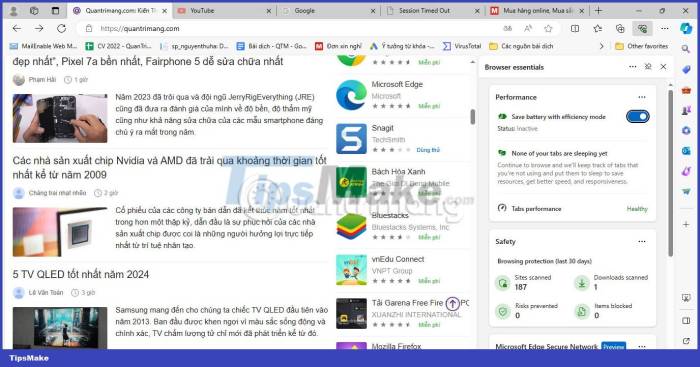Microsoft edge discourage chrome firefox – Microsoft Edge: Challenging Chrome and Firefox, is more than just a browser. It’s a statement of intent, a bold move to disrupt the dominance of Chrome and Firefox in the web browsing landscape. Microsoft has poured significant effort into making Edge a compelling alternative, boasting a suite of features designed to appeal to both everyday users and tech-savvy individuals.
This article delves into the strengths of Microsoft Edge, comparing its features, performance, security, and integration with the Microsoft ecosystem against its formidable competitors. We’ll explore how Edge is strategically positioned to attract users, offering a unique blend of functionality, security, and user-friendliness.
Microsoft Edge’s Features and Strengths
Microsoft Edge is a modern web browser developed by Microsoft. While it might not be as widely used as Chrome or Firefox, it boasts a range of features designed to enhance user experience and offer competitive advantages.
Integration with Windows
Edge is deeply integrated with the Windows operating system. This integration provides a seamless and efficient browsing experience, especially for users who rely heavily on Microsoft’s ecosystem. For example, Edge can easily access and manage files stored on OneDrive, the cloud storage service from Microsoft. This allows users to access and edit their documents, photos, and other files directly from the browser.
Performance and Security Comparisons
When choosing a web browser, performance and security are crucial factors. Edge, Chrome, and Firefox are all popular options, each with its strengths and weaknesses in these areas.
Performance Comparison
Performance encompasses various aspects, including speed, resource consumption, and responsiveness. Here’s a breakdown:
- Speed: In general, Chrome is known for its speed and responsiveness, often outperforming Firefox and Edge. This is attributed to its efficient JavaScript engine (V8) and optimized rendering pipeline. Edge has made significant improvements in recent versions, approaching Chrome in speed, particularly in resource-intensive tasks like video playback. Firefox, while traditionally slower, has been working to improve its performance with the introduction of features like multi-process architecture.
- Resource Consumption: Chrome has a reputation for being resource-intensive, consuming a significant amount of RAM and CPU power. This can lead to slower system performance, especially on devices with limited resources. Edge, on the other hand, is generally more efficient in terms of resource usage, particularly on battery life. Firefox sits somewhere in between, consuming more resources than Edge but less than Chrome.
- Responsiveness: Responsiveness refers to how quickly a browser reacts to user input. Chrome and Edge are known for their smooth and responsive performance, while Firefox can sometimes experience slight delays, especially when handling complex web pages or multiple tabs.
Security Features and Vulnerabilities, Microsoft edge discourage chrome firefox
Security is a paramount concern when browsing the internet. All three browsers have implemented robust security features, but vulnerabilities can arise and are constantly addressed through updates.
- Security Features: Edge, Chrome, and Firefox all offer features like sandboxing, which isolates web pages from the operating system to prevent malicious code from accessing sensitive data. They also employ anti-phishing and malware detection mechanisms to protect users from online threats. Additionally, they support HTTPS encryption, ensuring secure communication between the browser and websites.
- Vulnerabilities: Despite robust security features, all browsers are susceptible to vulnerabilities. These can arise from coding errors, design flaws, or even malicious actors exploiting weaknesses in the software. Regular updates are crucial to patch vulnerabilities and maintain a secure browsing environment. However, the frequency and severity of vulnerabilities can vary across browsers.
Potential Risks Associated with Each Browser
While all browsers present some level of risk, specific factors can influence the potential risks associated with each one.
- Chrome: Chrome’s widespread popularity makes it a target for attackers. Its large user base means that any vulnerability discovered can potentially impact a significant number of users. Additionally, Chrome’s extensions can pose security risks if not carefully selected and managed.
- Firefox: Firefox has a smaller user base than Chrome, making it a less attractive target for attackers. However, Firefox’s focus on privacy and its open-source nature can make it susceptible to vulnerabilities that might not be immediately addressed. Additionally, Firefox’s addon ecosystem can also introduce security risks if not carefully managed.
- Edge: Edge has a relatively smaller market share compared to Chrome and Firefox, making it a less common target for attackers. However, its integration with Windows and its reliance on Microsoft’s security updates can make it vulnerable to system-wide security issues. Additionally, Edge’s reliance on Microsoft’s security practices and its relatively smaller user base can make it more susceptible to vulnerabilities that might not be immediately addressed.
Last Recap: Microsoft Edge Discourage Chrome Firefox
In a world dominated by Chrome and Firefox, Microsoft Edge is making its presence felt. Its focus on security, integration with the Microsoft ecosystem, and a user-friendly interface make it a viable option for those seeking a change. While the market share battle continues, Microsoft Edge has clearly staked its claim, presenting a compelling alternative for users who demand a more secure and integrated browsing experience.
Microsoft’s push to encourage users to switch from Chrome and Firefox to Edge has been aggressive, with features like the integration of Edge into Windows 10. This approach has been met with some resistance, and now, Microsoft will no longer detail changes made through Windows 10 patches , making it harder for users to understand the potential impact of updates on their browsing experience, including the performance of Edge.
While this move might seem like a step back in transparency, it could also be seen as a way for Microsoft to focus on making Edge more user-friendly without being scrutinized for potential performance impacts.
 Securesion Berita Informatif Terbaru
Securesion Berita Informatif Terbaru
